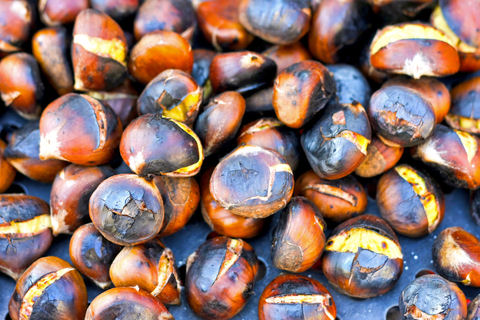The summer is now well behind us, the days getting colder and the days are noticeably shorter as we fast approach winter and soon, no doubt, the frosts will be here. But with the cold weather comes log fires (I lit the first of the season a few days ago), and with a log fire comes chestnuts.

When I used to live in Barcelona I used to see vendors with little cones of chestnuts in the city centre, particularly around Plaça Catalunya but after having seen a pan, full of holes, in a local store and being told it was designed for cooking chestnuts, I decided to have a go at home.
Early attempts over a gas hob weren’t that successful. They did at least cook but created a massive amount of mess too. However, once we moved out of the city and armed with a fireplace and wood to burn, chestnuts took on a charm of their own. In fact, walking around the neighbourhood in the winter you can sometimes smell chestnuts cooking as other people keep warm, or at least the imagination is driven into overdrive to create that smell for you.
In Catalonia chestnuts are called castanyers and a feast based around chestnuts – castanyada – traditionally eaten on All Saints Day but which more recently has moved to the night before – Halloween. In addition to roasted chestnuts, the feast includes a small marzipan cake called a panellet, the most common type which is covered in pine nuts, and sweet potatoes, all washed down by Moscatell.
The origins of the tradition are disputed, with some sources saying chestnuts were eaten by bell ringers on the eve of All Saints Day (i.e. Halloween) to keep warm while ringing the bells for the dead. Others say it dates from the eighteenth century when chestnuts were served at the funeral meal and prayers said while they roasted. Either way, the castanyada is related to the dead.
Last year seemed to be a poor year for chestnuts though, a short season and not particularly good, but in a good year they must go on for some six weeks or so. To prepare them you need to identify any that are full of worms (they tend to feel hollow), cut through the skin at one end and then place them in the pan over the fire.
They soon cook and fill the living room with a glorious nutty smell and although the first few are always too hot, they soon cool down so the fingers can soon cope; crack off the charred skin and eat. Although I’ve never eaten chestnuts as part of a castanyada, they are one of the great things of winter so if you have a fire and can get hold of chestnuts – wherever you live – I urge you to try cooking them at home, if only once.

